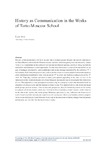Mostrar o rexistro simple do ítem
History as Communication in the works of Tartu-Moscow Schoool
| dc.contributor.author | Pern, Tanel | es_ES |
| dc.date.accessioned | 2014-10-02T12:31:28Z | |
| dc.date.available | 2014-10-02T12:31:28Z | |
| dc.date.issued | 2012 | es_ES |
| dc.identifier.citation | Culture of communication / Communication of culture, 2012: 453-458. ISBN: 978-84-9749-522-6 | es_ES |
| dc.identifier.isbn | 978-84-9749-522-6 | es_ES |
| dc.identifier.uri | http://hdl.handle.net/2183/13340 | |
| dc.description.abstract | [Abstract] The aim of this presentation will be to try and find a common ground between the cultural semiotics of the Tartu-Moscow school and the Western semiotic tradition which has greatly been influenced by Charles Peirce. I will concentrate on the works of Yuri Lotman and Boriss Uspensky, and try to bring out both the similarities and differences in their approaches. Lotman finds that human culture can be treated both as the sum of messages circulated by various addressers and as one message transmitted by the collective “I” if the humanity itself; from this point of view, culture can be viewed as a vast example of autocommunication, where information transferred in time from an earlier “I” to a later one leads to a restructuring of the “I” itself. For Uspensky, semiotic approach to history presupposes appealing to the point of view of the participants in the historical process: only those things are meaningful that are meaningful from their point of view. This approach, in turn, presupposes reconstructing the conceptual system that determines both the perception of certain events and the reaction to these events. This applies both to individuals and larger social groups, such as cultures. From the semiotic perspective, then, the historical process can be viewed as a process of communication where new information that is constantly created causes a certain reaction on the side of the receiver (the social group). Historical experience, in turn, influences the future turn of events: based on similar concepts and experiences, the society as a collective personality creates a program for the future and plans its future behavior. Every step in the movement of history changes both the present and the past, and with this also the future turn of events | es_ES |
| dc.language.iso | eng | es_ES |
| dc.publisher | Universidade da Coruña | es_ES |
| dc.title | History as Communication in the works of Tartu-Moscow Schoool | es_ES |
| dc.type | info:eu-repo/semantics/conferenceObject | es_ES |
| dc.rights.access | info:eu-repo/semantics/openAccess | es_ES |






